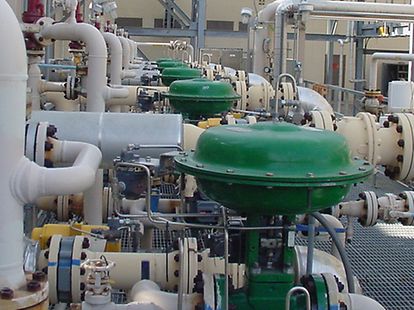Discovering the Capability of Modern Control Valves in Industrial Applications
Discovering the Capability of Modern Control Valves in Industrial Applications
Blog Article

Maximize Power Savings and Comfort With Advanced Building Automation Controls
In the realm of modern-day style and facility administration, the integration of innovative structure automation manages stands as an essential development. By using the power of automation, buildings can adapt, react, and develop in means that were as soon as unbelievable.
Power Efficiency Advantages
Energy performance benefits can substantially minimize power consumption and functional costs in structures. Energy-efficient systems, such as advanced structure automation controls, can optimize the usage of sources like home heating, air conditioning, and lighting, leading to reduced energy expenses over time.
In addition, boosted power performance can lengthen the life expectancy of structure devices and systems. By running a lot more efficiently, HVAC systems, lighting fixture, and various other structure components experience less damage, causing lowered maintenance and replacement costs. Furthermore, energy-efficient buildings commonly regulate higher property values and rental rates, giving long-term economic benefits to owners.
In addition, power efficiency can boost owner comfort and productivity. Appropriately controlled interior atmospheres with optimum lights and thermal problems create a more pleasurable and favorable office, bring about boosted worker fulfillment and efficiency. On the whole, the power effectiveness advantages associated with innovative building automation controls are complex, incorporating cost financial savings, environmental stewardship, and owner wellness.
Enhanced Comfort Control
Enhancing convenience control in structure settings calls for a sophisticated integration of sophisticated automation systems for optimal passenger wellness. By making use of sophisticated structure automation controls, facilities can tailor the interior atmosphere to satisfy the particular requirements and preferences of occupants. control valves.
Improved convenience control exceeds basic temperature adjustments. It includes attributes such as individualized setups, tenancy sensing units, and natural light usage to produce a responsive and vibrant atmosphere. By including these sophisticated controls, buildings can not only enhance convenience but additionally boost power effectiveness by optimizing system operations based upon actual occupancy and usage patterns. Eventually, focusing on resident comfort through sophisticated automation systems brings about an extra enjoyable and much healthier indoor environment.
Operational Efficiency Improvements

Furthermore, the application of real-time surveillance and analytics tools allows structure drivers to recognize energy inefficiencies and functional abnormalities quickly. By continually keeping track of power use patterns and system efficiency metrics, adjustments can be made in real-time to optimize power usage and make sure peak operational performance. control valves. Additionally, including demand response techniques right into structure automation controls can additionally improve operational performance by dynamically changing power use based upon grid conditions and pricing signals
Indoor Environment Optimization
Efficient indoor climate optimization is a basic element of structure automation controls, guaranteeing residents' convenience and wellness while maximizing energy cost savings. By making use of sophisticated sensors and controls, building automation systems can continually monitor and adjust temperature level, moisture levels, air quality, and ventilation to create an optimal interior atmosphere. Maintaining regular and comfy problems not only enhances occupant complete satisfaction yet additionally increases performance and total well-being.
Interior environment optimization also plays an important role click to read in power efficiency. By fine-tuning ventilation, home heating, and air conditioning systems based upon real-time data and occupancy patterns, developing automation controls can considerably decrease energy intake - control valves. Executing methods such as demand-controlled air flow and thermal zoning can aid decrease energy waste while guaranteeing that each location of the structure receives the necessary conditioning.

Sustainable Atmosphere Creation
Structure automation regulates not only maximize indoor environment conditions for power performance and passenger comfort yet likewise lay the foundation for creating a sustainable setting through calculated monitoring of systems and sources. By incorporating innovative building automation technologies, such as sensing units, actuators, and smart software application, facilities can adjust and keep an eye on energy use in real-time to lessen waste and lower their carbon footprint. These systems make it possible for predictive upkeep, determining possible issues before they intensify and maximizing devices performance to boost longevity and efficiency.
Furthermore, sustainable environment creation expands beyond power monitoring to incorporate water preservation, waste reduction, and interior air top quality enhancement. Structure automation controls can manage water use, detect leaks, and make sure correct garbage disposal techniques, adding to total sustainability efforts. Furthermore, by managing and keeping an eye on ventilation and filtration systems, these technologies enhance passenger health and performance while lowering Bonuses power intake linked with HVAC procedures.
Conclusion
Finally, progressed building automation manages offer considerable advantages in regards to power cost savings, convenience control, operational efficiency, interior climate optimization, and producing a sustainable environment. By implementing these controls, buildings can achieve optimal efficiency while reducing power consumption and enhancing owner convenience. It is apparent that making use of sophisticated automation modern technology is crucial in enhancing structure performance and producing a much more lasting future.
Energy performance advantages can substantially decrease energy consumption and functional costs in buildings. On the whole, the power performance benefits associated with sophisticated building automation controls are multifaceted, incorporating expense savings, ecological stewardship, and passenger well-being.
Additionally, including demand feedback techniques into structure automation controls can additionally improve operational performance by dynamically changing power usage based on grid problems and rates signals.
Structure automation Web Site manages not just optimize interior environment problems for energy efficiency and resident convenience yet additionally lay the foundation for creating a lasting environment with strategic management of systems and sources.In verdict, advanced building automation controls deal considerable advantages in terms of power savings, convenience control, functional performance, interior climate optimization, and developing a lasting setting.
Report this page